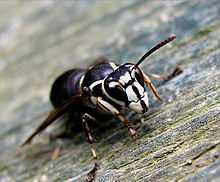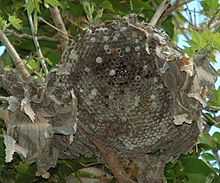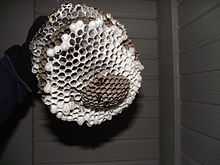Bald-faced hornet
| Bald-faced hornet | |
|---|---|
 | |
| Scientific classification | |
| Kingdom: | Animalia |
| Phylum: | Arthropoda |
| Class: | Insecta |
| Order: | Hymenoptera |
| Family: | Vespidae |
| Genus: | Dolichovespula |
| Species: | D. maculata |
| Binomial name | |
| Dolichovespula maculata (Linnaeus, 1763) | |
Dolichovespula maculata is a North American wasp commonly called the bald-faced hornet, white-faced hornet, white-tailed hornet, blackjacket or bull wasp. Its well-known features include its hanging paper nests and the females' habit of defending them with repeated stings.[1]
Description
The bald-faced hornet belongs to a genus of yellowjackets in North America, but unlike many congeners it lacks yellow coloring.[2] Instead, it is called a hornet in the American sense of a wasp that builds paper nests.[3] It is large compared to other yellowjackets, with adults averaging 2-3 cm long. It is sometimes confused with the similar-sized European hornet, the only true hornet in America, but is distinguished by its mostly white "baldfaced" head and three white stripes on the end of its abdomen.[2]
It is best known for its large, football-shaped paper nest, which it builds in the spring to rear young. The nest, one of the largest of wasp nests, can be up to 14 inches (35 cm) in diameter and 23 inches (60 cm) in length.[2] The population of a nest varies from 100 to 700 individuals, averaging around 400.[2] The bald-faced hornet is protective of the nest and will sting repeatedly if it is disturbed.[2] This wasp is more aggressive than most yellowjackets of Dolichovespula and the genus Vespula, and the nest should be observed only from a distance.
Distribution

The bald-faced hornet lives in North America, including southern Canada, the Rocky Mountains, the western coast of the United States, and most of the eastern US. It is most common in the southeastern United States.
Life cycle
_nest.JPG)
Each spring, queens that were born and fertilized at the end of the previous season begin new colonies. A queen selects a location for its nest, begins building it, lays a first batch of eggs and feeds this first group of larvae. These become workers and assume the chore of expanding the nest. They chew up wood, which mixes with a starch in their saliva. They then spread it around with their mandibles and legs, and it dries into a papery structure. The workers guard the nest and feed on nectar, tree sap and fruit pulp (particularly that of apples). They also prey on insects and other arthropods, chewing them up and feeding them to the larvae. They have been known to scavenge raw meat. In late summer and early fall, the queen begins to lay eggs which will become drones and new queens. After pupation, these fertile males and females fly off to mate and start new colonies.

As winter approaches, the wasps die, except the freshly fertilized queens. These hibernate underground, under logs or in hollow trees until spring. The nest is generally abandoned by winter, and will not be reused. When spring arrives, the young queens emerge and the cycle begins again.
The bald-faced hornet is considered useful by some people in that it preys on pest species of flies, caterpillars, and spiders. It is considered a pest itself, building hives of stinging insects near human habitation. It is a minor pollinator of some flowers.
Like other social wasps, bald-faced hornets have a caste system made up, in one nest, of the following:
- Queen – the fertile female which starts the colony and lays eggs
- Workers – infertile females which maintain the nest and young
- Drones – males, which lack stingers, and are born from unfertilized eggs
- New queens – fertile females, each of which may become a queen when fertilized and start a colony


References
- ↑ Foster, Steven; Caras, Roger; Peterson, Roger Tory (1998), A Field Guide to Venomous Animals and Poisonous Plants, North America, North of Mexico, Houghton Mifflin Harcourt, p. 48, ISBN 0-395-93608-X, retrieved 2010-03-03
- ↑ 2.0 2.1 2.2 2.3 2.4 Oswalt, Donald A.; Eric P. Benson (2013). "Baldfaced Hornets". Insect Fact Sheets. College of Agriculture, Forestry and Life Sciences, Clemson University. Retrieved March 3, 2013.
- ↑ "hornet", "Dictionary.com Unabridged, Random House, Inc., retrieved 2010-03-03 and The American Heritage Dictionary of the English Language, Fourth Edition, Houghton Mifflin Company, 2004.
External links
- Bald-faced hornet. PestWorld.org
- Bald-faced hornet. Hornets: Gentle Giants.
- Bald-faced hornet. Study of Northern Virginia Ecology. Fairfax County Public Schools. VA.